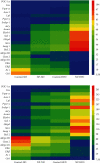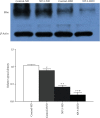High-Fat Diet Promotes Adipogenesis in Offspring Female Rats Induced by Perinatal Exposure to 4-Nonylphenol
- PMID: 37398946
- PMCID: PMC10313470
- DOI: 10.1155/2023/6540585
High-Fat Diet Promotes Adipogenesis in Offspring Female Rats Induced by Perinatal Exposure to 4-Nonylphenol
Abstract
Background: Both high-fat diet (HFD) and 4-nonylphenol (4-NP) could affect fat formation in adipose tissue individually. We investigated whether HFD promote abnormal adipose tissue formation caused by early exposure to 4-NP in life and preliminarily explore the possible mechanisms involved.
Methods: The first-generation rats were treated with HFD on postnatal day after pregnant rats exposure to 5 ug/kg/day 4-NP. Then, the second generation rats started to only receive normal diet without 4-NP or HFD. We analyzed organ coefficient and histopathology of fat tissues, biochemical index, and gene level involved in lipid metabolism in female offspring rats.
Results: HFD and 4-NP interaction synergistically increased birth weight, body weight, and organ coefficients of adipose tissue in offspring female rats. HFD accelerately aggravated abnormal lipid metabolism and increased the adipocyte mean areas around the uterus of the offspring female rats induced by prenatal exposure to 4-NP. HFD also facilitate the regulation of gene expression involved lipid metabolism in offspring female rats induced by perinatal exposure to 4-NP, even passed on to the second generation of female rats. Moreover, HFD and 4-NP interaction synergistically declined the gene and protein expression of estrogen receptor (ER) in the adipose tissue of second-generation female rats.
Conclusion: HFD and 4-NP synergistically regulate the expression of lipid metabolism genes in adipose tissue of F2 female rats and promote adipose tissue generation, leading to obesity in offspring rats, which is closely related to low expression of ER. Therefore, ER genes and proteins may be involved in the synergistic effect of HFD and 4-NP.
Copyright © 2023 Hongyu Zhang et al.
Conflict of interest statement
The authors declare that there are no conflicts of interest.
Figures






Similar articles
-
High-fat diet accelerate hepatic fatty acids synthesis in offspring male rats induced by perinatal exposure to nonylphenol.BMC Pharmacol Toxicol. 2021 Apr 27;22(1):22. doi: 10.1186/s40360-021-00492-z. BMC Pharmacol Toxicol. 2021. PMID: 33906686 Free PMC article.
-
Perinatal exposure to 4-nonylphenol affects adipogenesis in first and second generation rats offspring.Toxicol Lett. 2014 Mar 3;225(2):325-32. doi: 10.1016/j.toxlet.2013.12.011. Epub 2014 Jan 2. Toxicol Lett. 2014. PMID: 24388992
-
Supplementation of polar lipids-enriched milk fat globule membrane in high-fat diet-fed rats during pregnancy and lactation promotes brown/beige adipocyte development and prevents obesity in male offspring.FASEB J. 2020 Mar;34(3):4619-4634. doi: 10.1096/fj.201901867RRR. Epub 2020 Feb 5. FASEB J. 2020. PMID: 32020679
-
Perinatal maternal high-fat diet induces early obesity and sex-specific alterations of the endocannabinoid system in white and brown adipose tissue of weanling rat offspring.Br J Nutr. 2017 Nov;118(10):788-803. doi: 10.1017/S0007114517002884. Epub 2017 Nov 7. Br J Nutr. 2017. PMID: 29110748
-
Repercussions of maternal exposure to high-fat diet on offspring feeding behavior and body composition: a systematic review.J Dev Orig Health Dis. 2021 Apr;12(2):220-228. doi: 10.1017/S2040174420000318. Epub 2020 Apr 27. J Dev Orig Health Dis. 2021. PMID: 33754967
References
-
- Perez G. S., Cordeiro G. D. S., Santos L. S., Espírito-Santo D. D. A., Boaventura G. T., Barreto-Medeiros J. M. Does a high-fat diet-induced obesity model brown adipose tissue thermogenesis? A systematic review. Archives of Medical Science: AMS . 2021;17(3):596–602. doi: 10.5114/aoms.2019.86781. - DOI - PMC - PubMed
-
- Chung S. The development of isomer-specific analysis of branched 4-nonylphenol in food for dietary exposure - a critical review of analytical methods and occurrence in foodstuffs. Food Additives & Contaminants. Part A, Chemistry, Analysis, Control, Exposure & Risk Assessment . 2021;38(5):842–855. doi: 10.1080/19440049.2021.1889044. - DOI - PubMed
MeSH terms
Substances
LinkOut - more resources
Full Text Sources
Miscellaneous

